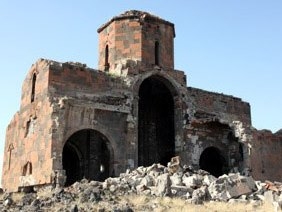Treasure seekers keep on destroying Armenian churches in Turkey
 17:13, 28 October 2013
17:13, 28 October 2013
YEREVAN, OCTOBER 28, ARMENPRESS: The local population is another threat to the Armenian churches of the Historical Armenia (now Turkey), who keep on digging the bases of the churches to master the Armenians’ treasures. Armenpress reports that the American Armenian writer and photographer Matthew Karanian wrote about it in the Armenian Weekly, after his trip to the Western Armenia.
“If you’ve ever watched a reality survival show on television—one of those shows were a couple of adventurers get dropped off in a desert with instructions to survive long enough to make it back home—then you might be able to conjure up an image of me hiking in Historic Armenia. I was on the shore of Lake Van, researching and photographing the Armenian churches of the region. My goal for this day was modest: hike to the ancient Armenian monastery of St. Thomas, a monastery that looks older than the treeless mountain that it’s perched upon. Survival was the last thing on my mind.
This was roughly about the same time that my supply of water ran out. Remember, survival had been the last thing on my mind. So, of course I hadn’t carried any water. The mid-day temperature was pushing closer to 100 degrees, and I had begun to reminisce about better times—like the time, earlier that day, when the mercury hadn’t yet risen above 90. I still wanted to see the church. But now that the risks of dehydration and heat stroke had been added to my itinerary, my priority was to make it back down the mountain. I wanted it all! I wanted to see the church, and I also wanted to survive.
I was hiking with Khatchig Mouradian, the Editor of the Armenian Weekly. He and I had the same goals. Better yet, he also had some water. He offered me half of what remained in his bottle. We were brothers in arms, and would share our water supply, 50-50. I reached for the bottle. It contained about two ounces of warm water. I was incredulous. “Really, Khatchig, I can only have one ounce?” Yes, he replied. “We will need the rest to survive.”
I took a drink, and we continued our ascent. There were no trees to shelter us from the sun as we scrambled up the mountain, but every two or three hundred feet there was some dwarf scrub that cast just enough shade to offer a bit of relief from the heat. We dashed from brush to brush, like soldiers in battle, until we had reached the monastic walls of St. Thomas. We discovered that the survival of the church was also at risk. The buildings of St. Thomas were constructed in the tenth and eleventh centuries, and are stoically sited on a mountaintop overlooking the southeast shore of Lake Van. The main surviving building, the cathedral, is about one thousand years old.
The current peril to the structure is caused, at least in part, by local people who are acting upon a long-discredited myth. Some of the Kurds who now live in Historic Armenia believe, incorrectly, that there is buried treasure at Armenian churches. And so some of these treasure seekers dig for gold and jewels wherever they see the ruins of an Armenian site. Judging from what I observed at St Thomas last month, some people appear to have believed that there was treasure hidden in the ground beneath this church, too. We saw holes dug in the earth near the foundation, at the entrance, and in the church yard. These excavations have undermined the foundation of St. Thomas, and similar burrowing undermines other churches, such as the nearby Karmravank, where treasure hunters have also sought supposedly long lost gold.
According to the discredited myth, Armenians buried gold and other valuables beneath the altars and near the points of entry to their churches. Ask a Kurdish villager if the Armenians supposedly did this while fleeing during the Genocide, or whether they buried their gold as a matter of routine in the years before the Genocide, and they are apt to just shrug their shoulders.
The odds of buying a winning lottery ticket are better than the odds of finding buried treasure at an Armenian church, because the odds of finding the buried treasure are zero. There’s no treasure. But people still buy lotto and they still dig for treasure. Even if the legend was true, which it isn’t, any treasure would surely have been dug up many years ago. Still, logic and truth have not deterred treasure hunters, even now, a century after the Armenians were expelled from this area.
As a result, the only treasures that really exist in places such as St. Thomas and at nearby Karmravank—the sacred structures themselves—are at risk of being destroyed. We made it safely back down the mountainside, and found plenty of shade and water. We lived to share the story of yet another ancient Armenian site that may not survive”, - wrote Matthew Karanian.





















